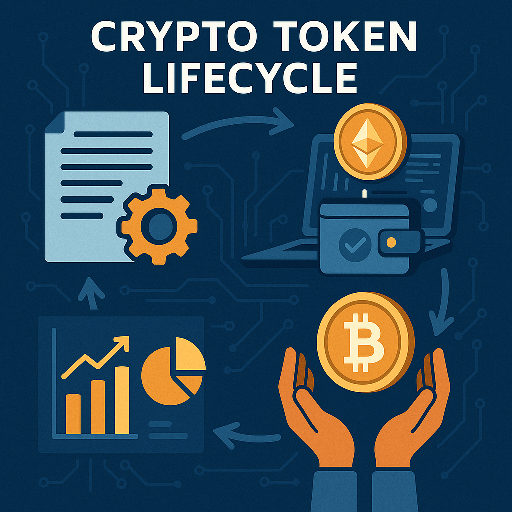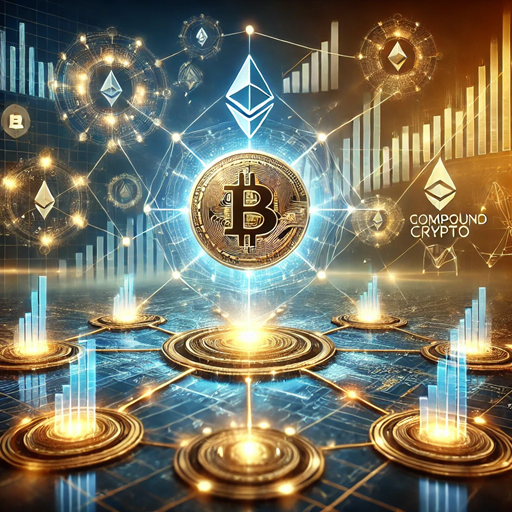The Crypto Token Lifecycle represents a structured process through which blockchain-based tokens are created, launched, distributed, and managed throughout their existence in the digital economy.
1. Introduction: Why Understanding the Lifecycle Matters
In the rapidly evolving blockchain ecosystem, tokens are more than just digital currencies. They are programmable assets that fuel decentralized applications, incentivize user behavior, govern protocols, and represent ownership or utility rights. Grasping how these tokens come into being, operate, and reach users helps entrepreneurs, investors, and developers make informed decisions.
2. Ideation and Purpose Definition in the Crypto Token Lifecycle
The initial phase centers on clarifying the core motivation behind introducing a new token. Defining the token’s value proposition, use case, and role within a system is critical to ensuring it serves a meaningful function.
To accomplish this, startups and decentralized organizations (DAOs) frequently engage in high-level strategic planning and analyze similar projects in the ecosystem.
Key questions at this stage include:
- Does the ecosystem genuinely require a new token, or can the project rely on the existing native cryptocurrency?
- What incentives or functionalities will the token provide to its users?
- How will it differentiate from existing alternatives?
3. Token Design: Economics, Governance, and Standards
Once the purpose is clear, the design phase addresses technical and economic characteristics. Decisions made here significantly impact user behavior and token performance over time.
Key Design Parameters:
- Total Supply: Fixed or inflationary.
- Distribution Mechanism: ICO, airdrop, yield farming, etc.
- Utility vs. Security: Functional or investment-oriented.
- Standards: ERC-20, ERC-721, BEP-20, etc.
The choice of standard determines interoperability and exchange compatibility. Developers often use frameworks like OpenZeppelin for security-audited token contracts.
4. Development and Smart Contract Deployment
With the specifications finalized, developers create smart contracts, usually on Ethereum or EVM-compatible chains. Solidity is the most common language for this.
Common Tasks:
- Coding token logic (minting, transferring, burning)
- Implementing access controls
- Creating pausable mechanisms and upgradeability
- Security auditing before deployment
Contracts are deployed via platforms like Remix or Truffle. Once deployed, the token becomes live and starts its journey through the blockchain network.
5. The Crypto Token Lifecycle and Legal Considerations
Legal frameworks surrounding tokens are still developing. Classification of a token (utility, security, governance) affects regulatory obligations.
Common Legal Issues:
- KYC/AML compliance for token sales
- Securities regulations in the U.S. (e.g., SEC’s Howey Test)
- Jurisdictional laws (e.g., MiCA in the EU)
- IP rights for tokenized assets
Token creators increasingly collaborate with legal advisors early to avoid future litigation or delisting from centralized exchanges.
6. Token Launch and Initial Distribution of Crypto Token Lifecycle
Once deployed and approved, the token enters the public domain through a launch event. This can take several forms:
- Initial Coin Offering (ICO)
- Initial DEX Offering (IDO)
- Airdrops
- Liquidity Mining
Marketing, community building, and partnerships are crucial at this stage to ensure adoption and liquidity. Whitepapers, roadmaps, and tokenomics documents are shared widely.
Early adoption is often incentivized through discounts, bonus tokens, or governance rights.
7. Listing on Exchanges and Enabling Market Access
To be tradable, tokens must be listed on exchanges. This step significantly boosts liquidity and public interest.
Exchange Types:
- Centralized (CEX): Binance, Coinbase
- Decentralized (DEX): Uniswap, PancakeSwap
Listing requires technical integrations, market-making strategies, and compliance with exchange policies. Token creators might offer incentives for liquidity providers or stake native tokens to boost visibility on DEXs.
8. Circulation and Token Utility in Ecosystems
Tokens gain value when actively used in their respective ecosystems. Common use cases include:
- Payment within a dApp
- Access to premium services
- Voting in DAO proposals
- Rewards for staking or participation
Robust ecosystem engagement hinges on meaningful use cases. Games, DeFi platforms, and NFT marketplaces often issue tokens to promote user activity and loyalty.
Evaluating transaction counts, the spread of token holders, and staking involvement becomes a key part of ecosystem monitoring.
9. Governance and Community Engagement
Community governance is a critical milestone in the Crypto Token Lifecycle. It signals a transition from hierarchical control to community-driven decisions made by token holders.
Governance Models:
- Token-based voting: Each token = 1 vote
- Quadratic voting: Balances influence of large holders
- Delegated voting: Elect representatives
Engaged communities drive sustainable ecosystems. Protocols like Compound or Aave showcase how DAOs use governance tokens to manage core parameters democratically.
10. Monitoring Token Health and Performance of Crypto Token Lifecycle
Ongoing token management ensures ecosystem stability. Teams must monitor both on-chain and off-chain indicators to measure success.
Key Metrics:
- Market cap and circulating supply
- Holder concentration
- Liquidity on exchanges
- Burn rate (if deflationary mechanisms exist)
Platforms like Etherscan, CoinGecko, and Dune Analytics provide dashboards and charts for transparent tracking. Token analytics help detect manipulation, price volatility, or declining usage early.
11. Token Updates, Forks, and Migration of Crypto Token Lifecycle
As technologies and markets evolve, tokens may undergo changes:
- Smart contract upgrades
- Token redenomination (e.g., 1000:1 split)
- Chain migration (e.g., Ethereum to Polygon)
Such transitions require strong communication strategies and secure bridges or wrappers. Projects like Sushiswap have successfully migrated without losing community trust.
12. Lifecycle Challenges and Threats of Crypto Token Lifecycle
Even well-designed tokens face challenges:
- Security breaches and exploits (e.g., flash loan attacks)
- Rug pulls or scams in unregulated IDOs
- Pump-and-dump cycles driven by hype
- Regulatory bans or sanctions
Mitigation involves audits, time-locked vaults, multi-signature treasuries, and ongoing transparency.
Community trust and resilience often determine whether a token survives long-term or fades away.
13. The Role of Burn and Buyback Mechanisms
Some tokens incorporate deflationary mechanisms as part of their lifecycle:
- Burning: Permanently removing tokens from circulation
- Buybacks: Project teams repurchase tokens to reduce supply
This helps counter inflation, stabilize prices, and reward long-term holders. Examples include Binance Coin (BNB) and Terra Classic (LUNC).
14. End-of-Life: Sunset or Evolution?
Some tokens reach the end of their lifecycle due to technical obsolescence, strategic pivots, or market failure. Others evolve into new products or merge into larger platforms.
Exit Strategies:
- Treasury redistribution
- Token swaps to new protocol
- Wind-down via governance vote
Honoring early holders and ensuring transparency during these transitions preserves brand integrity.
15. Case Studies Across the Crypto Token Lifecycle
Ethereum (ETH)
Though ETH isn’t classified as a token, its role as the foundational layer for smart contract development made tokenization possible on a global scale. Moreover, Ethereum’s shift from Proof-of-Work to Proof-of-Stake marked a significant turning point in the evolution of blockchain technology.
Uniswap (UNI)
Launched via airdrop, UNI now governs Uniswap’s treasury, protocol upgrades, and fee structures. Its lifecycle showcases the rise of decentralized governance.
Axie Infinity (AXS & SLP)
With dual tokens for gameplay and governance, Axie faced explosive growth followed by sharp corrections. Lifecycle analysis shows how excessive token inflation can undermine ecosystems.
Chainlink (LINK)
Despite lacking staking for years, LINK remained valuable due to oracle utility and strong partnerships. Its long-term roadmap and developer focus exemplify durability.
16. Future Trends Shaping the Crypto Token Lifecycle
The lifecycle model is evolving with technological innovation and regulatory shifts. Notable trends include:
- Evolving NFT mechanics where tokens change attributes over time
- Digitized representations of tangible assets like property, stocks, and debt instruments
- Tokens equipped with built-in regulatory safeguards are emerging as tools for ensuring compliance in decentralized ecosystems
- Application-specific modular blockchains optimized for token logic
The lifecycle is becoming more adaptive, security-conscious, and user-governed. Layer 2 solutions, account abstraction, and intent-centric dApps will further shape how tokens behave.
Conclusion: Mastering the Crypto Token Lifecycle
Understanding each phase of the Crypto Token Lifecycle empowers stakeholders to design, launch, and manage tokens that are secure, compliant, and impactful. Whether you are an investor, a founder, or a developer, aligning your decisions with lifecycle dynamics increases long-term value and user trust.
As Web3 infrastructure matures, lifecycle best practices will continue to evolve—offering a blueprint for building resilient and user-focused token economies.




















